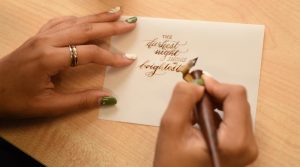The ABCs of a Freelancer—Samantha Cheung Meet the recipient of the S.H. Ho Eminent College Scholarship

Journalism and Communication Programme alumna
Recipient of S.H. Ho College Eminent College Scholarship 2015–16
How did you start English calligraphy?
I was deeply attracted by the classical taste of English calligraphy. I told my friend I only needed the special dip pen to start it. She gave me one as a birthday present last February. I then started learning English calligraphy from free online clips and became more and more enchanted. Later, I added design to the letterings and thought they would make good stickers. As I was still looking for a full-time job after graduation in late 2015, I started printing my designs out and selling them—first in S.H. Ho College’s Night in March. The feedback was great. I went on to share my works on my Facebook page, ‘Wood n Ink’, which was named to reflect my love for Nature and the essential tool for calligraphy.
Why did you choose to be a freelance English calligrapher instead of practising what you learned?
I was employed by an advertising company in April 2016 and was responsible for arranging the releasing schedule of advertisements on different platforms. Long working hours and a heavy workload left me with little energy or time for my calligraphy work. By July, I resigned. Calligraphy is something I’m truly passionate about and which makes me feel content and inspired. I began to get more attention and praises. Customers grew after seeing/purchasing my products and began to ask if I could do special sentences on cards, shop names or design logos for them. All these prompted me to turn my calligraphy hobby into a ‘business’.
How free can a freelancer be?
At first I didn’t receive many orders. I had to make ends meet by giving private tutorings and doing translation work. Frankly speaking, the only advantage of becoming a freelancer is getting up late. A freelancer is basically a one-man band. I am even busier than when I was employed. Completing the orders timely is a must so as to build up my reputation and getting returning customers.
How is your business going?
The competition is very keen. You can find hundreds of English calligraphy advertisements on the web. To be competitive, not only do I keep practising, but must also develop my personal style. The general requirement for calligraphy is to inscribe the words properly. I tend to incorporate my own sentiments in the form of simple lines or some natural shapes. In addition of stickers, I design diary books for customers to go with different stickers as gifts. I started teaching calligraphy in both private and corporate classes, including two workshops at S.H. Ho College, attracting quite a lot of students. My perseverance paid off, I believe. My income is close to that of working in the advertising company.
What does promoting calligraphy mean?
It allows people to express. It’s a way to channel your thoughts and emotions into words and images, then share with others.
Being awarded one of the most important scholarships at S.H. Ho College, how will you use the fund?
As mentioned above, I love Nature. I am naturally drawn to issues of the environment and animal protection. I plan to use the fund to study related issues abroad. I am applying for the MPhil in Environmental Policy at Cambridge University.
What are the most unforgettable moments of your hostel life at the College?
I appreciate the College’s effort in offering opportunities for its students to be exposed to foreign cultures, e.g., arranging social service trips to Uganda, inviting guests from various disciplines to speak at high table dinners. I fully uphold the idea of full residence. I met many friends there. Some have become my best friends who supported me to be a freelancer.
Reprinted from No. 491, CUHK Newsletter

